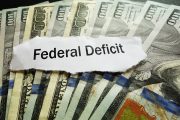
Once again, economic forecasters are embarrassed. Last August the highly regarded Penn Wharton School at the University of Pennsylvania predicted that Trump’s tax law, and the resultant repatriation of profits that America’s largest corporations had stashed overseas, would have only a modest impact on the U.S. economy. The authors of the study wrote that “direct economic effects from repatriated income are likely to be very small … that TCJA (Trump’s Tax Cuts and Jobs Act) will raise $254 billion in revenue over the next ten years [and its] indirect impact will be to increase GDP by less than 0.2 percent after ten years.”
Wednesday’s report from the Commerce Department completely obliterated the folks’ forecast at Penn Wharton: American companies repatriated $665 billion of their earnings in 2018, taking advantage of the law’s tax holiday provision. That’s in a single year, not over 10 years.
And the best is yet to come: There’s still an estimated $2.5 trillion in profits stashed overseas just waiting for a time such as this.
And what a time it is! The economy is not enjoying a temporary “sugar high” from Trump’s tax reform, but is just beginning to feel its impact. The non-partisan Joint Committee on Taxation joined Penn Wharton by being off the mark when it reported that the law’s benefits would peter out after a year or so. The committee argued that the tax law would stoke inflation, forcing the Fed to intervene by raising rates to cool things off.
The Fed did intervene (raising the fed funds rate by 1.0 percent, the biggest hike in any calendar year since 2005), justifying its interference by claiming it was worried about incipient inflation.
Those fears were unfounded. By its own preferred measure — the PCE or personal consumption expenditures index — inflation was below the Fed’s target. When Wall Street took notice late last year, driving stocks down by nearly 20 percent in a month, the Fed recanted, almost offering an apology for its hasty solution to a non-existent problem by announcing it would take a “wait-and-see” attitude toward further interest-rate hikes. Economist Stephen Moore, Trump’s appointee to fill one of the Fed’s Board of Governors vacancies, has already said publicly that he favors an interest-rate reduction.
Wall Street, the usual predictor of future economic activity, rebounded, with average gains in the double digits so far in 2019, with more to come.
Repatriation of profits from abroad bode well for 2019 and beyond. Like charcoal briquettes on a grill, it takes time for their benefits to show up. But once they do, then, to extend the analogy, things really start cooking.
Profits of American corporations were up 11.1 percent in the fourth quarter of 2018, while profits “per share” rose nearly 17 percent. That’s the fifth straight quarter of double-digit earnings growth for America’s largest companies.
That two-thirds of a trillion dollars recalled from abroad is currently being invested in new plants and equipment, new technology, new labor-saving hardware and software — and the results are already beginning to show up. Labor productivity, a measure that has languished for years, jumped 1.8 percent in 2018, compared with just 0.5 percent from 2012 to 2016.
American companies are using those repatriated profits to fund the “low-hanging fruit” — projects already on the drawing boards and approved once the funds were available. Now that America is the most-favored nation for foreign investors, the flood of billions from aboard will continue and is likely to increase bringing the higher-hanging, and even more profitable, fruit within reach.
The improved outlook being predicted by Wall Street is showing up in consumer and business sentiment. The Business Roundtable’s survey of future business expectations is 15 points higher than its 2012-16 average. And the University of Michigan’s consumer confidence index has nearly completely recovered from its swoon following the Fed’s intervention, to 97.8 from 91.2.
The trade gap with China is narrowing. It fell by 14 percent in January, reflecting American consumers’ increasing preferences for products made in America. It also reflects the jump in American soybean exports to China, from $300 million in December to $1.2 billion in January.
All of this bodes well for the U.S. economy, already producing more than $20 trillion of goods and services a year, leaving China (whose economy, at $13 trillion, is shrinking) and Japan (at $5 trillion) farther and farther behind.
If the president successfully concludes his negotiations with the Chinese communists, and is able to install enforceable rules that keep them from continuing to steal U.S. technology, the side benefit — lower tariffs — will help keep the U.S. economy humming for years.
An Ivy League graduate and former investment advisor, Bob is a regular contributor to The New American, writing primarily on economics and politics. He can be reached at [email protected].
Related article:
Jumps in Durable-goods Orders & Business Investment Confound Forecasters Again



